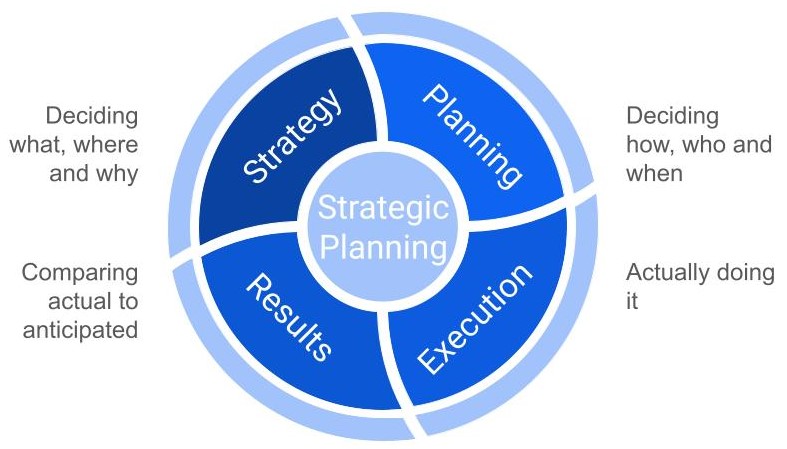What is Strategic Planning?
Strategic planning is the process of defining a business’s direction and making decisions on allocating resources—such as time, money, and human capital—to pursue that direction. It involves setting goals, determining actions to achieve those goals, and identifying the resources required. Strategic planning also includes evaluating and adjusting your approach as needed based on changing market conditions or internal factors.
At its core, strategic planning is about ensuring that your business is aligned with its mission, vision, and objectives, and that it is taking intentional actions to move toward those goals.
Why is Strategic Planning Important?
-
Clarifies the Business Vision: https://www.officeoneplus.com provides a clear roadmap for where the business is heading. It helps define the long-term vision and aligns everyone in the organization towards a common goal. Without a clear plan, businesses risk heading in multiple directions, leading to wasted resources and missed opportunities.
-
Improves Decision-Making: A well-defined strategy guides decision-making at all levels of the organization. When you know your priorities and objectives, you can make more informed choices that align with your long-term goals, rather than reacting to short-term challenges or distractions.
-
Enhances Resource Allocation: Strategic planning helps you allocate resources—time, money, and human capital—more effectively. It ensures that your efforts are focused on initiatives that will yield the greatest return on investment, minimizing waste and maximizing efficiency.
-
Identifies Opportunities and Threats: By regularly analyzing your business environment, strategic planning helps you identify new opportunities for growth and potential threats that could jeopardize your success. Being proactive allows you to capitalize on emerging trends and address challenges before they become obstacles.
-
Promotes Long-Term Growth: Strategic planning isn’t just about surviving the present; it’s about positioning your business for sustainable long-term growth. A strong strategy ensures that your company isn’t just reacting to market changes but is proactively shaping its future success.
Key Steps in the Strategic Planning Process
Creating a strategic plan involves several steps that guide businesses through the process of defining, implementing, and evaluating their strategy. Here’s a breakdown of the key steps involved:
1. Define Your Mission and Vision
Before you can develop a strategy, you need to understand your purpose and long-term aspirations. The mission outlines why your business exists, while the vision articulates where you want to be in the future. These two elements form the foundation of your strategic plan.
- Example: A tech company’s mission could be “To empower individuals and businesses through innovative technology solutions,” while its vision might be “To become the global leader in AI-driven software solutions by 2030.”
2. Conduct a SWOT Analysis
A SWOT analysis (Strengths, Weaknesses, Opportunities, and Threats) is a crucial tool for assessing your current position in the market. It helps you identify internal strengths and weaknesses and external opportunities and threats. This analysis provides valuable insights that inform your strategy and highlight areas where you can leverage your strengths or address potential risks.
- Example: Strengths might include a strong brand reputation, while weaknesses could be limited marketing reach. Opportunities may involve expanding into new markets, while threats could include increasing competition.
3. Set Clear, Achievable Goals
Strategic goals should be specific, measurable, achievable, relevant, and time-bound (SMART). These goals should align with your mission and vision and be broken down into short-term and long-term objectives. By setting clear goals, you can track progress and adjust your efforts if necessary.
- Example: A short-term goal could be “Increase website traffic by 20% in the next six months,” while a long-term goal might be “Expand to two new international markets within the next three years.”
4. Develop Action Plans
Once you’ve set your goals, the next step is to develop specific action plans that outline how you will achieve them. This includes identifying key initiatives, assigning responsibilities, and establishing timelines. Action plans provide a clear roadmap for execution and ensure that everyone in the organization knows their role in achieving the company’s strategic objectives.
- Example: If one of your goals is to increase sales, an action plan might involve hiring additional salespeople, investing in digital marketing campaigns, and improving customer relationship management (CRM) tools.
5. Allocate Resources
Strategic plans require adequate resources—financial, human, and technological—to execute successfully. You’ll need to allocate budgets, assign personnel, and invest in the tools and infrastructure necessary to support your initiatives. Ensuring that you have the resources in place is crucial for the success of your strategic plan.
- Example: If your strategy involves launching a new product, you may need to allocate funds for product development, marketing, and distribution.
6. Monitor Progress and Adjust
A strategic plan is a living document that needs to be regularly monitored and adjusted. Establishing key performance indicators (KPIs) helps you track progress toward your goals. Be prepared to adjust your strategy if you encounter unexpected challenges or if market conditions change.
- Example: If your sales numbers are not meeting expectations, you may need to pivot your approach, refine your messaging, or reassess your target audience.
7. Evaluate and Refine the Strategy
At the end of a set period (quarterly, annually), evaluate the outcomes of your strategy. Analyze what worked, what didn’t, and why. This analysis helps you refine your approach for the future and ensures continuous improvement in your strategic planning process.
- Example: If a marketing campaign didn’t generate the expected leads, evaluate the messaging, target audience, and channels used to determine what adjustments need to be made.
Best Practices for Effective Strategic Planning
To make sure your strategic plan is effective, here are some best practices to keep in mind:
-
Involve Key Stakeholders: Engage leaders and employees at all levels in the strategic planning process. Input from different perspectives helps ensure that the strategy reflects the collective insights of the organization.
-
Stay Flexible: The business environment is constantly evolving. Be prepared to adjust your strategy as new opportunities arise or challenges emerge.
-
Focus on Execution: A strategic plan is only as good as its execution. Ensure that there is clear ownership and accountability for each goal and action item.
-
Keep the Customer in Mind: Always focus on how your strategy benefits the customer. Customer-centric strategies are more likely to succeed because they address the needs and desires of your target market.
-
Track Metrics and Adjust: Consistently measure your performance against your goals and KPIs. Regularly track your progress and make adjustments to ensure you stay on course.
Conclusion
Strategic planning is a vital tool for guiding businesses toward growth and success. By defining your mission, setting clear goals, allocating resources, and continuously monitoring progress, you can ensure that your business stays on track and adapts to changes in the market. Whether you’re entering a new market, launching a product, or simply looking to improve internal operations, strategic planning provides a framework for making informed, deliberate decisions that drive long-term results.
Remember, strategic planning is not a one-time event—it’s an ongoing process that requires commitment, adaptability, and constant evaluation. By following the key steps outlined in this article, your business can achieve its goals and thrive in an increasingly competitive environment.





